The big push for transformation through climate and development

Download
Recommendations of the High-Level Advisory Group on Sustainable and Inclusive Recovery and Growth
This report has been prepared under the leadership of Mari Pangestu, Ceyla Pazarbasioglu and Nicholas Stern as the co-chairs of the High-Level Advisory Group (HLAG) on Sustainable and Inclusive Growth. The report summarises the insights derived from 10 meetings of the HLAG over its 1.5 years of existence, from a series of consultations, and from the reports produced to inform these meetings and consultations.
Overview
Countries were buffeted by twin crises in 2021: the COVID-19 pandemic and climate change. Difficulties in responding to the pandemic also highlighted and exacerbated the challenges from the accelerating climate crisis, with shocks coming at higher frequency and with greater intensity. Against this backdrop, the High-Level Advisory Group (HLAG) on Sustainable and Inclusive Recovery and Growth came together to provide policy analysis and practical proposals for actions that could help countries secure a strong recovery from the pandemic and a successful green transition.
The report:
- Makes the case for a big investment push for sustainable recovery and development in emerging markets and developing economies (EMDEs)
- Assesses the magnitude and composition of such investment
- Presents actions needed for an energy transition
- Examines the role that innovations and state capacity can play in facilitating a high-growth green, resilient, and inclusive development (‘GRID’) path
- Proposes actions that governments, the private sector, multilateral development banks (MDBs), the IMF and donors can undertake to mobilise financing at the large scale needed.
Summary recommendations
Strategies and policies
- Policymakers and development partners adopt an effective approach to growth and development that eschews the damaging ways of the past, considers interlinkages among people, the planet, and the global economy in policymaking, and seizes the opportunities new technological possibilities offer to promote strong, resilient, inclusive, and sustainable growth.
- Countries urgently initiate a major investment push to transform their energy systems, adapt and build resilience to climate change, protect and restore natural capital, and promote development,and the investments undertaken cut across mitigation, adaptation, and resilience to avert the rising cost of climate inaction and seize the opportunities for growth in the new global green economy.
- Governments create demand for energy transition projects through ambitious long-term strategies underpinned by sound planning.
- Stakeholders at the global and country levels adjust the policy environment to correct systemic failures. Governments develop long-term investment strategies and undertake reforms to improve the investment climate, deepen financial markets, and tackle political economy, governance and market failures. Regulators and supervisors develop a supportive international sustainable financial architecture.
- Governments promote green technological innovation and diffusion, with support from the development partner community, and provide a clear sense of direction and policy certainty to encourage firms to redirect innovation toward green technologies.
Institutions
- Governments adopt a whole-of-government institutional approach to help address fragmentation of governance systems, develop the required new skills within government, and facilitate the needed coordinated action across government branches and among government, firms, and citizens, as well as at the international level.
- Governments set up or strengthen country-led and country-owned coordination mechanisms to accelerate investments in green, resilient, and inclusive development and the transformation of key systems.
- Governments adopt second-generation fiscal rules to improve fiscal policy and rebuild fiscal space to support critical investments in a fiscally sustainable way.
Integrated finance
- An integrated financing strategy is adopted at the country and global level, employing the complementary strengths of different pools of finance and supported by five actions: 1) donors at least double mitigation, adaptation, and development financing, including concessional financing, by 2025 compared with their 2019 levels, and steadily increase them further by 2030; 2) MDBs and the IMF are supported in evolving in the face of multiple crises; 3) the private sector, MDBs and the IMF help scale up private sector financing for climate and development; 4) stakeholders support debt restructuring; 5) governments bolster domestic resource mobilisation by removing wasteful fuel and agricultural subsidies and redirecting resources and increase fiscal space.
Published by the World Bank Group.

